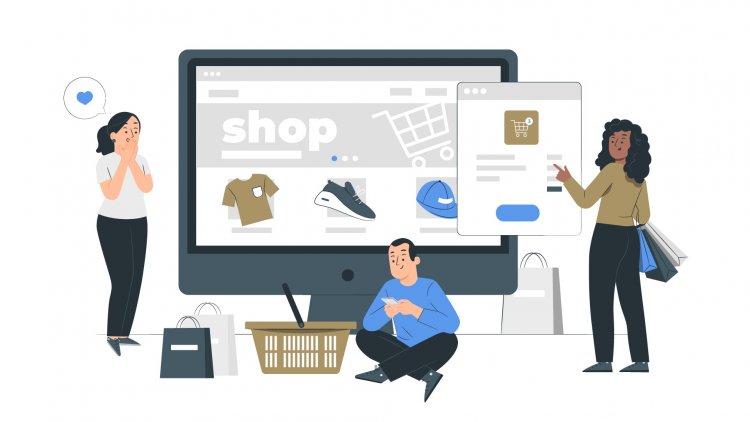The height of the Covid-19 pandemic is almost behind us, and people are looking toward a more hopeful future again. Daily cases are dropping gradually, life appears to be returning to a sense of normality, and business sectors are beginning their recovery including Hospitality, Travel, and Retail. However, returning to our previous styles of business, and expecting pre-pandemic heights may not be as simple.
The world is definitely not the same, as well as the way business is conducted. Shopping amongst the busy streets and crowded malls might soon become a myth of the past. Consumers are moderately moving towards e-commerce and online shopping. However, strengthening and investing in a brand’s digital presence is the answer to puzzling post-covid recovery?
Enter Online Shopping Centre Stage
It is a fact that the pandemic drastically affected the lives of people around the globe, with restrictions and lockdowns resulting in increased unemployment and decreased investment rates. However now that we are emerging on the other side, can we harness these changes and arise stronger?
As the saying goes, when one door closes another door might open. With the downfall of the physical aspect of business, another aspect has flourished, with the rise in digital customer experience. Since the introduction of lockdowns, e-commerce and m-commerce have become significant functions of every enterprise. The market quickly realised that even without physical business, there is still a prospect to continue sales online. Henceforth, respectively investors and consumers, are witnessing the vast rise in e-commerce platforms that notably supports the post-covid recovery of worldwide business.
Take East Asian markets, for example, they are seeing a significant increase in the e-commerce sectors. China, which is arguably the biggest Asian market, recorded e-commerce retail sales of over $2,700 billion. Additionally, their overseas neighbour, Japan, experienced staggering sales of almost $170 billion in retail sales. Both demonstrate that although the pandemic all but froze our social lives for two years, business never stopped; it adapted to overcome the continued obstacles.
The importance and urgency to establish a strong online presence is now apparent across the board from small local businesses to global corporations. Upcoming start-ups have also begun shifting their pillars of focus towards digital strategies for sales success. In India, Amazon is offering a chance for local offline stores to sell groceries on their platform. The programme was introduced in 2020 and extended for the year 2021. Currently, Amazon’s programme includes more than 100 million shops in 450 cities and is planning to extend the number of participating businesses to 1 million by 2025.
Impressively, India is one of the largest e-commerce markets in the world. Studies show that online sales within retail have risen significantly from $66 billion in 2021 to a staggering $80 billion this year. Forecasts also predict $145 billion in sales by 2025. At this rate, India is progressing to become the second-fastest growing economy in Asia all due to its strong e-commerce presence.
The Worldwide Takeover of the Digital World
According to a United Nations Conference on Trade and Development (UNCTAD) report, online retail sales have seen a significant increase in developed economies. The United Kingdom’s sales have risen from $89 billion in 2019 to $134 billion in 2020. Another enormous jump has been recorded in the US, in 2019 the online retail profits were estimated at $598 billion and in the first year of the pandemic, increased by $200 billion.
Moreover, the two most influential e-commerce platforms in the world, Amazon, and Alibaba showed record-breaking increases in profits during the beginning of the outbreak. American e-commerce giant, Amazon, had a GMV change of 17% between the years 2019 and 2020. Their Chinese competitor, Alibaba, also had a noteworthy rise of 10%. Ultimately, even Shopify, the popular e-commerce platform with over 1 million active users, broke its own profit records in 2020. The platform made almost $60 billion in a single year!
While many business services were hindered during the lockdown period, online presence grew to new heights. Sooner or later, e-commerce will overtake a crucial part of retail, it is inevitable that consumers will move to more comfortable shopping, online and the pandemic only propelled that forecast. Today, a business can hardly be conducted without a strong digital existence. Social media marketing campaigns and promotion on various digital channels are essential for growth, for both small and medium enterprises; as well as sustaining high revenue for global corporations.
The Growth of Business Post-Covid
Starting and holding a successful business can be tricky, especially in the post-covid era where the market is still vulnerable and fragile. Many enterprises did not survive the pandemic and others struggled to bring back pre-covid profits. The new trends are showing an increase in business interest in the online presence and specifically e-commerce. The Western Europe market had enormous growth in e-commerce, back in 2015 the total online sales income was estimated at $200 billion, but in the spike of the Covid-19 pandemic, digital shopping reached over $450 billion in the previous year.
These trends demonstrate that consumers completed purchases online more than ever before. Partially due to the fact that, especially during the times of Covid, online shopping became much more convenient, no longer having to leave their beds or put on clothes to complete a purchase. The upper hand is clearly on the side of e-commerce retail, and the advantage is only rising. Technological improvements in the communication sector allow consumers to do their groceries from their mobile devices. For example, in India, 80% of online sales are done via mobile phones. Henceforth, the digital business sector is experiencing the rise of m-commerce. Notably, over 50% of total e-commerce sales are generated by customers’ smartphones. The m-commerce sector is still new and has limitless potential for improvement. In the last 5 years, the total m-commerce sales have increased by a staggering 40%.
Mobile commercial transactions can also be conducted in person. There is a popular trend among consumers to pay with their phones instead of swiping credit cards. Apple Pay, which is a pioneer of this technology has over 380 million users worldwide, to put that into perspective that is more than the total population of the United Kingdom. The payment solution offers the convenience of paying with your phone and security to store all the debit and credit cards.
Many people were afraid to leave their households during the pandemic, supermarket giant Lidl leveraged this sad fact to produce an innovative new feature. They launched ‘Lidl Plus’, offering customers the possibility to shop for goods from their smartphones. According to the data from Google Play and Apple Store, Lidl Plus has totally been downloaded over 1.3 million times and that is just in September.
Concluding, respectively e-commerce and m-commerce are on the track to become the main support of the retail sector. Both are still relatively young and already are putting record-breaking revenue numbers. It is only a matter of time until shoppers completely move to digital purchasing. Social media and online advertising for goods are necessary for the brand’s success as well as strong, reliable products. Imagine it this way, a company can build the best cars in the world but without discussing it on social media platforms they are bound to sell only in their districts. Digital marketing allows brands to reach a wider customer base, the aspect that is a requirement in today’s economy and that is a fact.
1-0 Online Vs in Person Shopping
The proof is in the pudding, as data across the globe demonstrates that following the pandemic e-commerce sector is much more reliable than in-person business. Additionally, online enterprises are much more cost-efficient and effective in comparison to the opening walk-in store. Conducting business online helps owners to track site engagement and analyse what products sell better. Obtainable digital data is much broader and can give considerable insights.
The success of Fashion Nova, a women’s retailer, shows that business can grow only with a strong online presence. The company has merely 5 in-person stores in just one state of America, and yet last year recorded revenue of $520 million. How is that possible? Fashion Nova ships its products worldwide, which means instead of being limited to the customer base only in California, now they can reach the whole world. E-commerce and digitalization of business allow entrepreneurs to reach broader audiences. However, just having an online store is not enough for the multi-million dollar revenue. Social media marketing campaigns, targeted advertisement, online promotions, and personalised emails are all essential to building successful brand awareness.
The convenience and reliability of e-commerce deliver astonishing results in the company’s revenue. Together with well-organised brand awareness and social media promotions business has a much higher chance of success.
Concluding Influence of E-commerce on Business
E-commerce plays a significant role in how all businesses recover revenue in these challenging post-covid times. The digital world has unparalleled opportunities to offer for both customers and businesses. The world is an unpredictable place, two years ago a global outbreak of Coronavirus ravaged businesses. Stores are vulnerable to vandalism, larceny, and even natural disasters like tornadoes or earthquakes. E-Commerce has emerged as the shining light at the end of the tunnel for many. Additionally, giving the advantage of functional analytic tools, so the owners can track the trends and attention of their customers, and thus adapt accordingly.
E-commerce’s growing influence and popularity supported global business during testing times and is now ready to pave the way to a stronger digital future. In the aftermath of lockdowns, entrepreneurs see the digitalization of stores as an investment opportunity. Facts and numbers do not lie, and the picture is clearer than ever. Consumers are more likely to spend money online than in stores, and the sales reports from the last two years are evidence of this phenomenon.
Technological improvements are only a fast-forwarding process of clientele moving towards online shopping. Decades ago the majority of people never even heard of e-commerce, today people are casually ordering groceries from their mobile phones. The rapid growth of social media in recent years is powering this effect, companies can use such platforms to reach global audiences and expand their business to new limits. It’s time for you to get involved and enter the new world stronger.






















